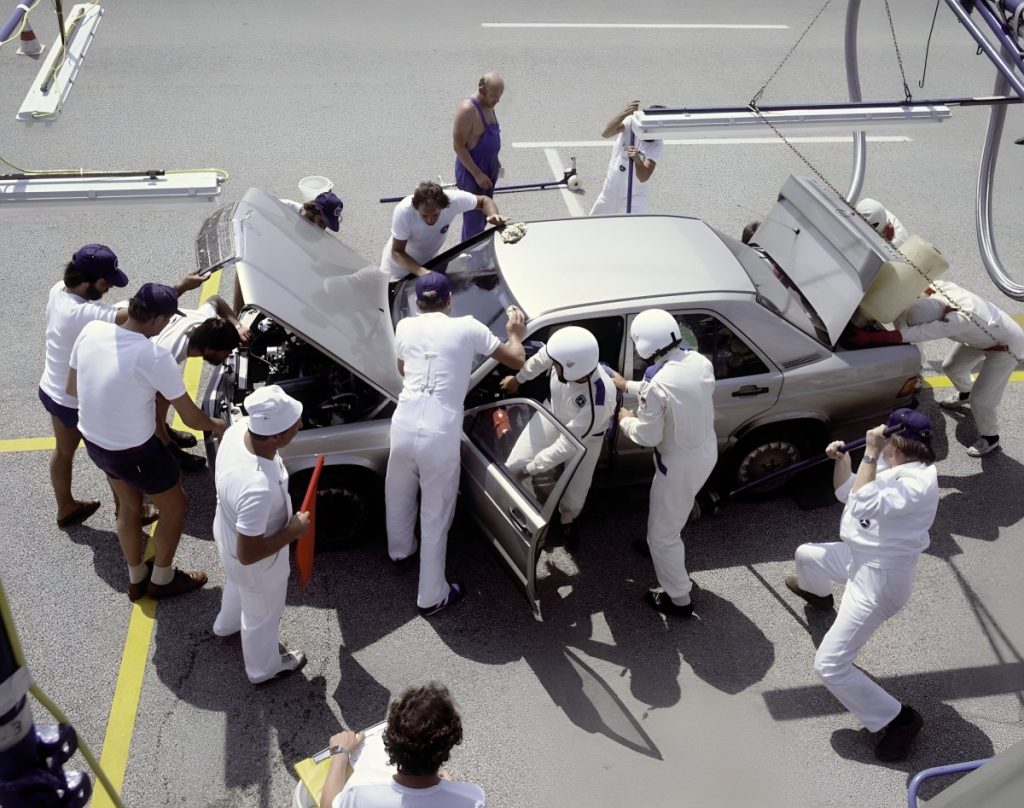In the vibrant and groovy 70s, as flared trousers swayed with the rhythm, Mercedes-Benz took a daring leap into uncharted territory by introducing the compact sedan, the baby Benz. The aim was clear: to challenge BMW’s successful e30 model.
To achieve this feat, Mercedes-Benz invested a staggering £600 million in research and development for the W201, which would later be affectionately labeled ‘massively over-engineered’. Pioneering innovations like the multi-link rear suspension with individual upper and lower control arms set it apart as a trailblazer in the automotive world. All of this design ingenuity was brought to life under the guidance of the legendary Bruno Sacco, head of styling at Mercedes-Benz from 1975 to 1999.
Testing of the early prototypes began in 1978, and after careful refining, the final styling was approved on March 6, 1979. By February 1982, pilot production had already commenced. Mercedes-Benz initially introduced two engine options for the W201: the carburetor 190 and the more powerful 190E, featuring Bosch KE Jetronic fuel injection. The response to the W201 was nothing short of extraordinary, swiftly establishing itself as the most desirable small sedan on the market.
However, before we delve further into the legendary W201 190E 2.3-16, let’s take a moment to explore Mercedes-Benz’s history with motorsport, which played a crucial role in inspiring this iconic car’s birth. Following a tragic event during the 1955 24 Hours of Le Mans race, where a Mercedes-Benz 300 SLR race car crashed into the grandstand, resulting in the deaths of driver Pierre Levegh and 83 spectators, Mercedes-Benz made the ethical decision to withdraw from all motorsport activities. It was a period of mourning and reflection for the company, focusing on safety and respect.
In the late 1960s, Mercedes-Benz discreetly supported AMG’s efforts in the European Touring Car Championship, culminating in a remarkable second-place finish for the mighty Mercedes-Benz W109 300 SEL V8 at the 1971 24 Hours of Spa. This success reignited Mercedes-Benz’s motorsport ambitions, and they ventured into long-distance rallying, achieving victories with production-based models like the W123 280E during the 1977 season. You can check out the “Storytime” section of our website to read about how well the 280s performed in the extremely long-distance rally, the 1977 London to Sydney Marathon.
In the years 1978 and 1979, the C107 450SLC performed exceptionally well. A “Storytime” post about this car will be available in the near future. The success on the rally stages led Mercedes-Benz to collaborate with Cosworth Engineering in England to develop an enhanced, more potent cylinder head for a Group B rally version of the W201. However, Audi’s introduction of the first 4WD car for rallying, the ‘Quattro’, in 1982 changed the landscape, leading Mercedes-Benz to shelve their plan.
Undeterred by past disappointments, Mercedes-Benz pressed on with their motorsport aspirations, determined to forge ahead with, this time, a Group A version of the 190E. Unlike Group B, which demanded a mere 200 cars for homologation within a twelve-month period, Group A mandated a higher threshold of 5,000 cars. The new Mercedes-Benz W201 190E 2.3-16 was proudly unveiled at the Frankfurt Motor Show in September 1983, with production beginning twelve months later.
The core of the 2.3-16 was its engine, developed in collaboration with Cosworth, who had already started developing the 16-valve cylinder head with mechanical valve lifters, producing an impressive 185 hp from its 2.3-liter displacement. The engine was fitted with this light alloy cylinder head, dual overhead camshafts, and four valves per cylinder, hence the “2.3-16” moniker. The engine had a compression ratio of 10.5:1, with 185 hp at 6,000 rpm and 235 Nm at 4,500 rpm. The W201 2.3-16 sprinted from 0-100 km/h in 7.5 seconds, reaching a top speed of 230 km/h. The car’s exceptional performance was complemented by a Getrag five-speed manual dog-leg gearbox, with first gear positioned left and down from neutral. This meant that the remaining 2nd, 3rd, 4th, and 5th gears were in a simple H pattern, allowing fast and easy selection. In contrast to most Mercedes-Benz cars, 5th gear was not used as an overdrive but was really destined to reach top speed. The gear ratios were 4.08:1/2.52:1/1.77:1/1.26:1/1.00:1/R 4.40:1.
Additionally, the 2.3-16 featured a 32% limited slip differential and a multilink rear suspension. Mercedes-Benz made significant enhancements to this suspension. They equipped the 2.3-16 with shortened and stiffer springs and firmer dampers. The anti-roll bars were beefed up, and a self-leveling rear axle was installed. As a result, the ride height was lowered by 15mm at the front and 12mm at the rear, giving the vehicle improved handling dynamics.
Visually, the 2.3-16 showcased its sporty spirit with an aggressive body kit, which included a lower front and rear spoiler, side skirts, fender extensions, and a rear wing on the trunk. The bumpers and exterior mirrors sported an elegant satin black finish, reflecting Mercedes-Benz’s tradition of refined restraint. The car rolled on special 7×15 Gullideckel alloy wheels fitted with Pirelli P6 tires, ensuring a balanced and responsive ride. Inside, the 2.3-16 offered a unique blend of features, with hard-wearing, soft-touch black plastic and vinyl, complemented by black leather seat bolsters and checked fabric-trimmed seat centers and door panels. The heavily bolstered sports seats provided remarkable comfort and support, and a curved instrument cluster housed a large speedometer, a rev counter with an analog clock, and a combined gauge for fuel level, water temperature, oil pressure, and fuel economy.
The center console featured two more readouts—an ammeter and an oil temperature gauge. It also housed a digital stopwatch, all hinting at the car’s sporting intentions. Mercedes-Benz offered the 2.3-16 in two colors: Blue-Black Metallic (color code: 199) and Smoke Silver (color code: 972). A range of optional upgrades were available, including ABS, full leather upholstery, air conditioning, electric windows, a sunroof, and various audio and safety features. The Anti-Slip Differential (ASD), a hydraulically locking differential maximizing traction, was also offered as an optional extra, reinforcing the car’s performance-oriented character.
Before its debut at the Frankfurt Motor Show, Mercedes-Benz demonstrated the car’s unwavering reliability through a record-breaking endeavor. In August 1983, three Mercedes-Benz 190E 2.3-16 cars set out on an exacting high-speed test run, conquering a challenging 50,000 kilometers with an average speed of 247 km/h. The cars achieved three world records and set nine international class records, all without any major issues, a testament to their exceptional engineering. Mercedes-Benz further showcased the capabilities of their sporty baby Benz by holding a promotional event at the brand new Nürburgring Grand Prix Course, involving 20 top Formula 1 drivers. You can delve deeper into this race in the “Storytime” section of our website.
Mercedes-Benz introduced several technical changes during the production of the 2.3-16. Early 1984 examples of the car had minor differences, including a twin-blade wiper arm on the right side, a slightly different hood, and a grooved rear spoiler. In 1985, optional upgrades were introduced, such as a four-speed automatic gearbox and self-leveling front suspension.
In 1986, two new engine options were unveiled, both utilizing the same M102 E23/2 type number. The KAT engine featured a catalytic converter and a 9.7:1 compression ratio, producing 170 bhp and 162lb-ft of torque. This version allowed Mercedes-Benz to meet the stringent emission regulations in the United States during 1986 and 1987, making the 2.3-16 available in that market. The RUF engine, another option in 1986, was an unleaded fuel version without a catalytic converter. With a slightly higher output of 177 bhp and 170lb-ft of torque, this variant maintained a 9.7:1 compression ratio. In 1987, Mercedes-Benz made the previously optional Anti-Slip Differential (ASD) a standard feature on the 2.3-16, further enhancing the car’s traction capabilities.
The Mercedes-Benz 190 E 2.3-16 serves as a testament to the dedication, engineering excellence, and motorsport heritage of Mercedes-Benz. Its introduction marked a new chapter for the brand, showcasing their ability to create a compact yet formidable sports sedan.
In the future, we will delve deeper into the later W201 2.5-16, exploring its advancements and innovations as Mercedes-Benz continued to push the boundaries of performance and engineering in their pursuit of automotive excellence. As always, stay tuned for more exciting stories in our “Storytime” section, where we continue to explore the fascinating world of petrol-fueled insanity.







